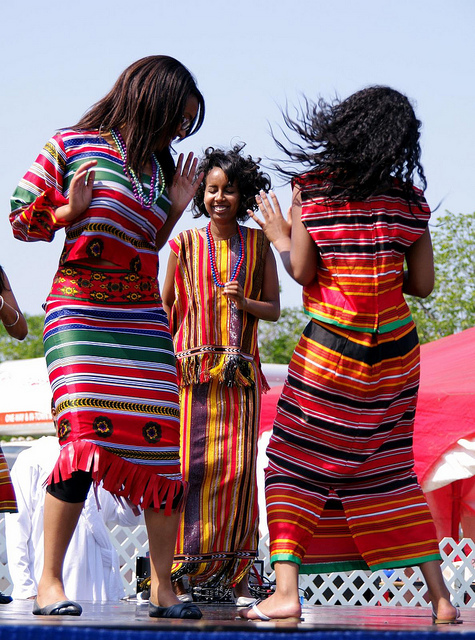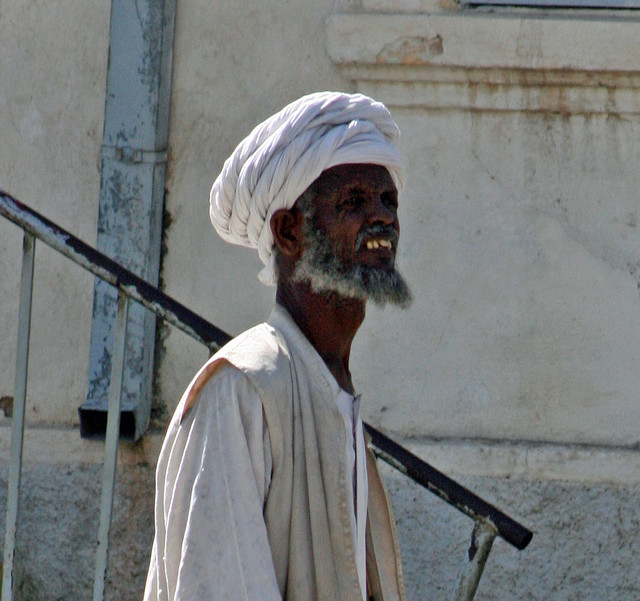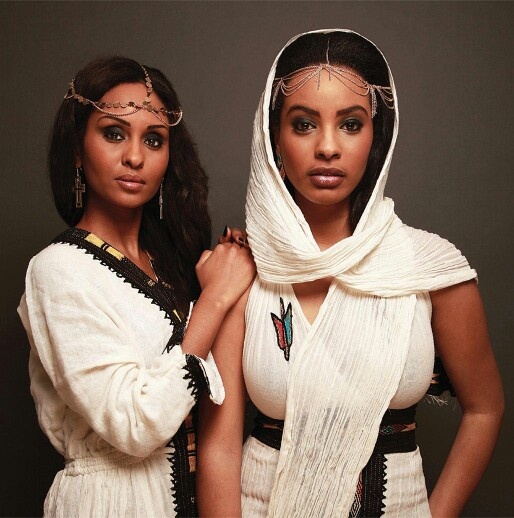
Eritrean girls dancing in traditional outfits. Image by Kurt Bauschardt
Eritrea is one of the four countries from Horn of Africa having multi-ethnic population and Asmara as its capital. This multilingual country which is located along the Red Sea coast has several ethnic groups and each one of them has their own distinctive traditional clothing. Urban people in Eritrea have adopted the western clothing as you’ll find people wearing jeans and shirts in casual wear while in the offices with western suits. Traditional dress of Eritrea is however worn by some communities, still in their domestic affairs and also in cultural celebrations. On the whole, traditional dress of Eritrea is a bright colored garment and proudly worn as conventional attire by Eritreans.

Traditionally the women of Eritrea in villages mostly wear a hooded dress which is known as Zuria. This garment goes to the ankles, with a gauze hood around the head and shoulders. New dress designers in Eritrea are nowadays making Zuria in various styles and patterns as the popularity of the dress is still continued.

Habesha people are living in the Eritrean highlands for many centuries who are the founders of the great Abyssinian civilization in Africa. Habesha people in Eritrea are known for cattle herding and agriculture. Habesha women of Eritrea normally wear the Habisha Kamis which is ankle length attire and it is customarily made with chiffon which comes in white, grey or beige shades. In the wedding ceremonies or formal events, most of the Eritrean women also wear a shawl called a netela. Netela is actually a handmade cloth used to cover the head and shoulders. Some women also wear a similar form of cloth which is known as Gabi and it consists of four layers.

Kidan Habesha is a more cultural and festive garment both for the men and women in Eritrea which consists of shirts and trousers. It also includes a thin fabric which is wrapped over the shirts around the shoulders and chest. Kidan Habesha is preferred to be worn with intricately designed stick and white shoes.

The people living in the southern and the central parts of Eritrea mostly belong to Tigrinya ethnicity. They primarily live in a region of Eritrea known as the Kebessa. Traditional Tigray clothing is white, which is regarded as Christian, with little adornment. In the formal occasions, the traditional Tigary dress for women comprises of an ankle-length garment with long sleeves made with precious material. Tigrinyan men wear ankle-length pants that are tight from the knee to the ankle and baggy in the upper legs and hips. A fitted, long-sleeved shirt normally covers the upper body.

Rashaida or Rashaayda is a local tribe of Eritrea who dwell in Eritrea and South Sudan. In the mod of the nineteenth century, these people migrated from Saudi Arabia due to the tribal warfare. These people depend upon the cattle herding primarily breeding goats and sheep and pass a nomadic lifestyle. They still possess their own traditional lifestyle, custom and clothing which are unique in Africa. Rashaidas are thought to be related to the Bedouin of Saudi Arabia and are the only true nomadic people left in Eritrea. Rashaida people make up five percent of the population of Eritrea of about 5.75 million people.

Rashaida women are known for their unique dress code. There traditional outfits are normally black-and-red geometrically patterned garments along with their conventional veils that are called as Burqa. Burqa for a Rashaida woman is a long garments usually adorned with heavy embroidery of silver thread, beads and sometimes seed pearls. It is compulsory for the Rashaida woman to wear this costume since her childhood. Rashaida women are very conservative and normally cover their faces in public. The veil is removed only when they are alone with their husbands. The Eritrean Rashaida men wear their traditional outfits bedecked with swords and knives and popular for their folk dances. Rashaidas are largely Muslims and are considered as the Eritrean gypsies who live in isolated communities, preferring not to live with other tribes.

A small ethnic group of Africa which is known as Kunama people has the largest portion of its population in Eritrea. They are considered as the oldest nomadic ethnic group of Africa. Although some Kunamas still practice traditional beliefs but most of them have adopted Christianity and Islam. Like other nomads of Eritrea they also depend upon agriculture and animal husbandry. The famous dresses for Kunama people of Eirtrea include Ballada and Matalita for men and Adalkana which is usually worn by Kunama women of Eritrea. These outfits are specially prepared for the cultural Tuka-Satta and Galli-Gala festivals by the Kunama people.

Hairstyle is a feature that must be collaborated with the traditional clothing of Eritrea. Almost every ethnic community in Eritrea has its own unique hairstyle. Popular and traditional hairstyle in Eritrea includes; Albaso which usually consists of seven large braids that flow back till the end extends out like a fur coat. Gamme hairstyle is intended for adolescent girls who haven’t married. This hairstyle usually features braids being braided to the sides and backward. Tigre men, they style their hair in a fluffy crown like shape that have long ringlets hanging down on the sides. This type of hairstyle is known as the tiffa in the Hidareb language.

Traditional jewelry in Eritrea also plays a significant role in the country’s heritage as it represents the extraordinary handcrafted skill of the Eritrean goldsmiths and craftsmen. In the rural areas of Eritrea, making of handcrafted jewelry is also a primary source of earning. Each ethnic community in Eritrea has its own individual jewelry making art. Both Eritrean men and women are involved in this business. The historians have strong belief that the jewelry making tradition has a very long history since the first human in-habitation in Eritrea.

For more interesting posts with the same subject on the Lovely Planet Website, please click the following links;
1- Algerian Traditional Dress 2- Traditional Dress Of Serbia 3- Traditional Dress Of Kosovo 4- Traditional Dress Of Libya 5- Traditional Dress Of Morocco 6- Traditional Dress Of Albania 7- Traditional Dress Of Tunisia 8- Traditional Dress Of Lebanon 9- Traditional Dress Of Bosnia And Herzegovina 10- Traditional Dress Of Azerbaijan 11- Traditional Dress Of Turkmenistan 12- Traditional Dress Of Kazakhstan 13- Traditional Dress Of Kyrgyzstan 14- Traditional Dress Of Uzbekistan 15- Traditional Dress Of Tajikistan 16- The Traditional Dress Of Laos 17- The Traditional Dress Of Vietnam 18- Traditional Dresses Of The World – 1 19- Traditional Dress Of Jammu & Kashmir 20- Ottoman Dresses From Turkey 21- Colors Of Cholistan 22- Cultural Dresses Of Balochistan 23- Lehenga Choli Or Ghagra Choli 24- Sari Or Saree : Traditional Dress Of Women In South Asia 25- Ajrak , The Traditional Attire From Sindh , Pakistan 26- The Traditional Tais Of East Timor 27- Shalwar Kameez: The Popular Dress Of South Asia 28- Churidar Pajama: The Favorite South Asian Attire 29- Pakistani Bridal Dress 30- Rilli, Sindhi Quilt Art 31- Fantastic, Alluring Khussa Shoes 32- Customs And Traditions Of Kalash Tribe 33- Hanfu, The Classical Chinese Dress 34- London Fashion Week 35- Fashion Week Milan: The Glamorous Event Of Italy 36- New York Fashion Week 37- Paris Fashion Week 38- Traditional Dress Of Jordan 39- Traditional Dress Of Syria 40- Traditional Dress Of Afghanistan 41- Traditional Dress Of Palestine 42- Traditional Dress Of Oman 43-Traditional Dress Of Nigeria 44- Traditional Dress Of Hungary 45-Traditional Dress Of Ukraine 46- Malaysian Traditional Dress 47- Traditional Dress Of Kenya 48- Traditional Eastern Brides 49- Traditional Dress Of Bulgaria 50- Traditional dress of Uganda 51- Traditional Dress of Iceland 52- Traditional Dress of Croatia 53- traditional dress of Norway 54- Traditional dress of Finland 55- Traditional Dress of Philippines 56- Traditional dress of Denmark 57- Traditional dress of Belarus 58- Traditional Dress of Puerto Rico 59- Traditional Dress of Nicaragua: Marvelous and colorful 60 – Traditional Dress of Nepal: Whimsical but charming 61- Brilliant Colors of Dagestan: Really fanciful and imaginative 62- Kabuki: A classical and traditional Japanese theater 63- Boogie-woogie: A famous Swing Dance 64- Colors of Samba Dance from Brazil: So lively so amazing 65- Ho Jamalo: The favorite folk dance of Sindh 66- Odissi from the Eastern India: A historic ritual dance 67- Sattriya from Assam: A classical Indian dance 68- Fandango: A famous couple dance from Spain 69- Maypole from Europe: A fabulous circle folk dance 70- Cueca: The national dance of Chile 71- Traditional dress of Belgium: A charming European attire 72- Traditional dress of the Kingdom of Saudi Arabia 73- Colors of Kalash: 5 lovely images of beautiful Kalash girls 74- Traditional dress of Georgia: The fantastic Chokha 75- Traditional dress of Argentina: The warrior Gaucho costume 76- Traditional dress of Venezuela: Not complicated but decorated 77- Traditional dress of Latvia: Made with the Linen fabric 78- Traditional dress of Romania: So captivating and graceful 79- Traditional dress of Estonia: So classy and versatile 80- Traditional dress of Armenia: So colorful and diversified 81- Traditional dress of Angola: A symbol of the ethnic culture 82- Traditional dress of Austria: Dirndl, Lederhosen and Tracht 83-Traditional dress of Namibia: Far from the modernizations 84- Traditional dress of Zambia: Rare but unique in nature 85- Traditional dress of Slovakia: Kroje , decorated and cultural 86. Traditional dress of Qatar: Pure Arabian endowment 87. Traditional dress of Brazil: So bright and colorful in nature 88. Traditional dress of Colombia: So iconic in Latin America 89. Traditional dress of Chile: So artistic and cultural 90. Traditional dress of Mexico: Blend of indigenous and imported cultures 91- Traditional dress of Panama: The exotic Mola and La Pollera 92- Traditional dress of Cuba: A product of multi-cultural effects 93- Traditional dress of Bangladesh: So awesome in its nature and kind 94- Traditional dress of Indonesia: Featured with unique patterns and designs 95- Traditional dress of Pakistan: Legacy of ancient civilizations 96- Traditional dress of Russia: A symbol of ethnic diversity in the Russian Federation 97- Traditional dress of England: Outcome of the local and European clothing repercussions 98- Traditional dress of Mauritania: Fusion of Berber and African cultures 99- Traditional dress of Egypt: Legacy of ancient Kings and Queens 100- Traditional dress of Iran: A product of the glorious Persian heritage 101- Traditional dress of Iraq & Kurdistan: Offshoot of the ancient acculturation 102- Traditional dress of Costa Rica: A charming garb of Latin America 103- Traditional dress of Italy: A garnished garment with beauty and style 104- Traditional dress of Antigua and Barbuda